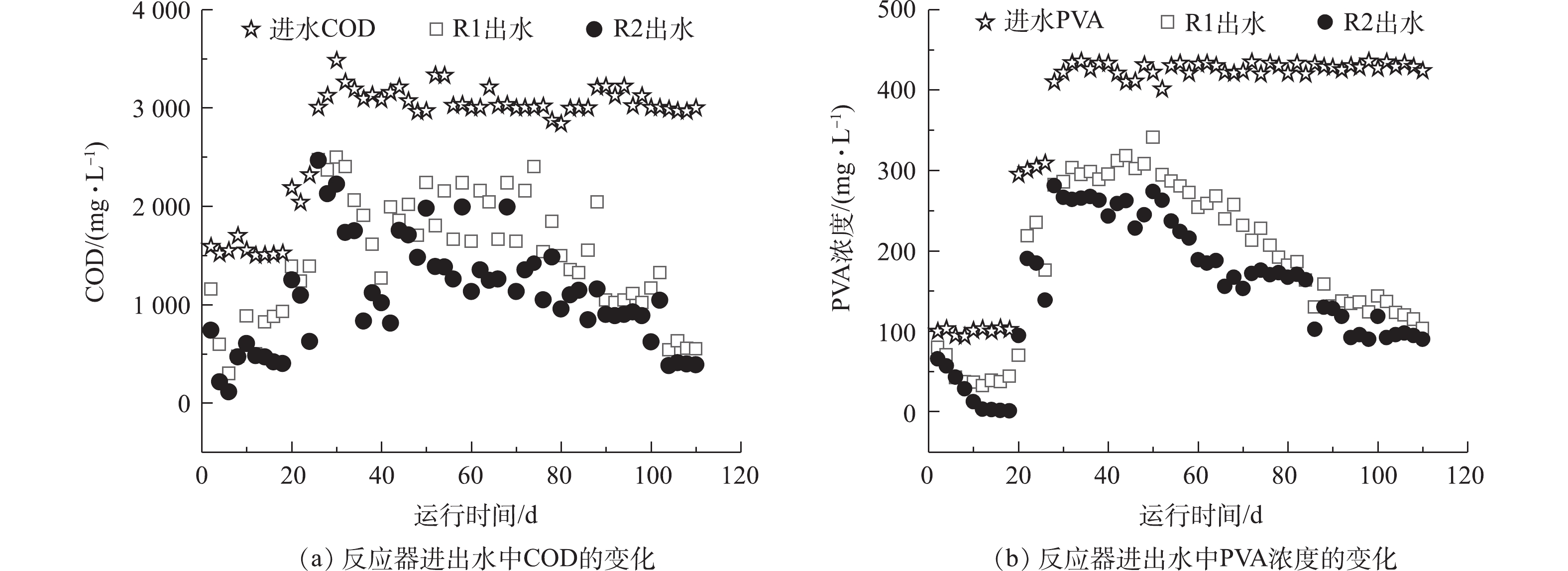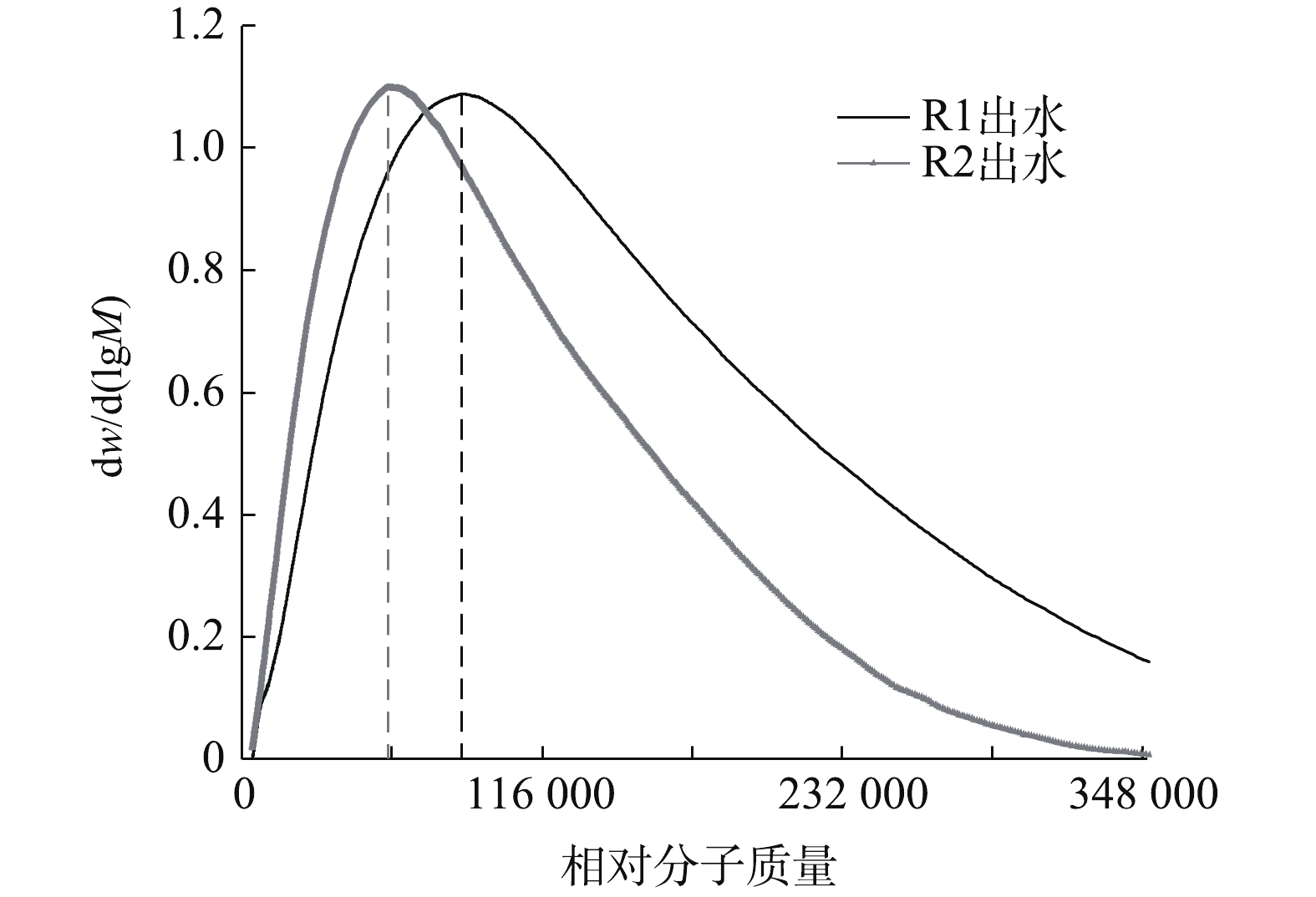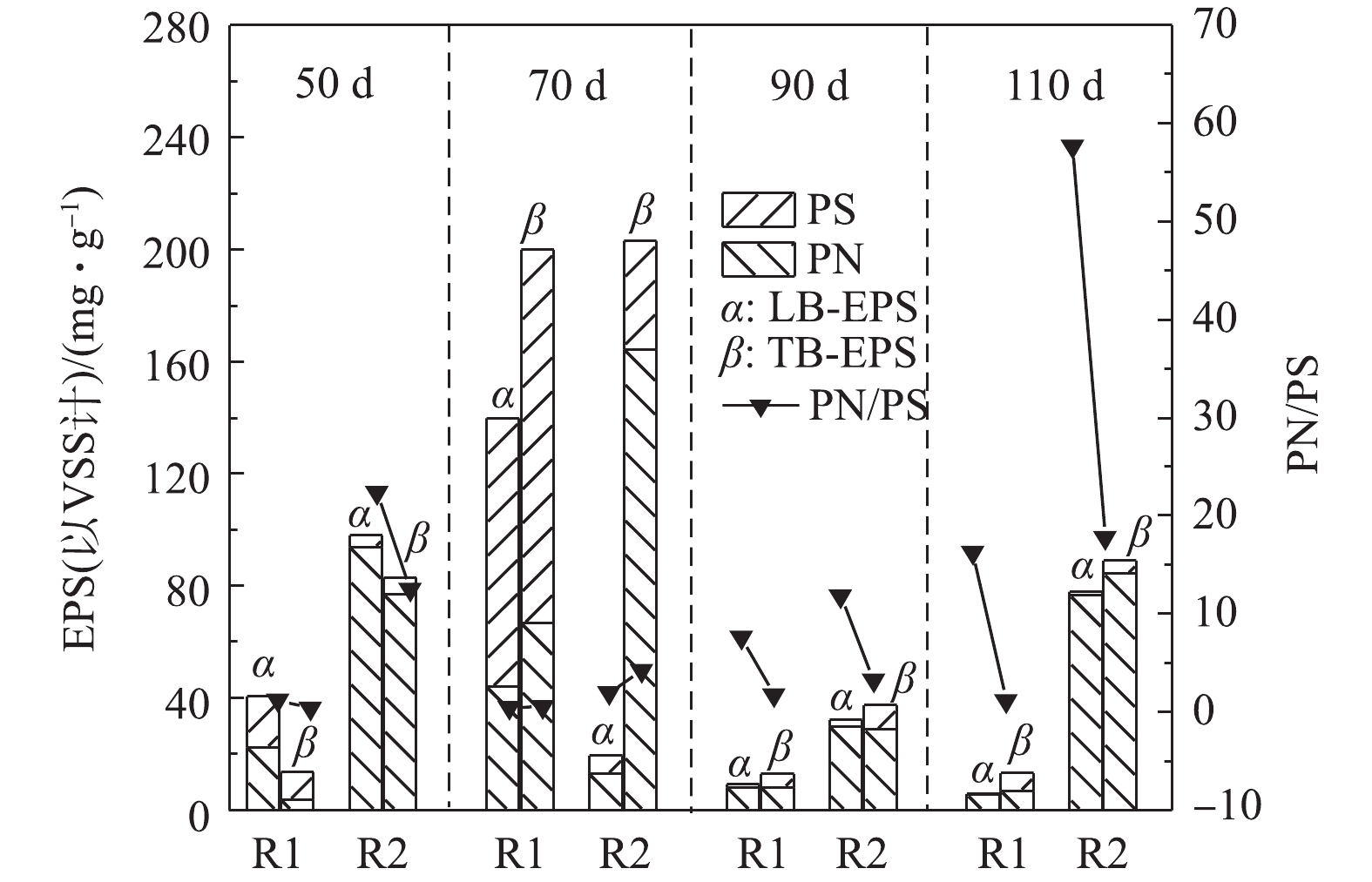-
印染行业是我国具有国际竞争力的传统优势产业,但同时也是典型的高能耗、高水耗、高污染行业。印染加工过程产生的废水(包括退浆废水、煮练废水、染色废水、印花废水和整理废水等)具有水量大、有机污染物含量高、水质变化大、废水回用率低等特点,是典型的难处理工业废水[1-2]。
聚乙烯醇(PVA)是一种水溶性高分子聚合物,因其具有良好的上浆性、黏附性和耐磨性而被广泛应用于纺织上浆工序。为得到均匀、持久的染色及后整理效果,织物上浆后须进行充分退浆,退浆过程产生的含PVA废水是一类水量小但污染物浓度高的印染废水,可生化性差,处理难度大[3]。目前,PVA退浆废水的处理方法主要包括物理法、化学法及生物法。通过超滤工艺处理PVA退浆废水可实现PVA的回收利用,但膜孔易堵塞,膜污染问题严重[4]。芬顿类氧化法须严格控制pH,反应时间等工艺条件,应用范围受限,且会产生大量铁泥,增加处理成本[5]。有研究者[6-7]通过选育和培养PVA高效降解菌来处理PVA退浆废水,但由于降解酶活性低,培养周期长,提取难度大,实际应用性受到一定的限制性。
铁炭微电解是一种基于金属腐蚀电化学基本原理,利用铁和炭浸泡在电解质溶液中形成无数微小原电池,由此引起电化学还原、电沉积、絮凝吸附等一系列作用的高效废水处理技术[8]。微电解反应产生的初生态Fe2+具有强还原性,可氧化废水中的某些基团,同时反应产生的新生态[·H]具有极高的化学活性,可以破坏废水中有机物的结构,可大幅提高废水的可生化性[9-10]。Fe2+、Fe3+还具有絮凝作用,可通过混凝和沉淀去除污染物,并加速颗粒污泥的颗粒化,促进厌氧消化[11-12]。此外,铁炭微电解中的铁屑还可以缓解厌氧反应器的有机酸积累,维持pH稳定[13]。铁炭微电解工艺因效果显著被广泛应用于印染、化工等难降解废水处理领域,但通常作为预处理技术与生物法等其他方法联用。联用工艺不仅消耗大量铁炭材料,还会出现铁屑锈蚀、板结以及大量剩余污泥产生等现象,且生物法水力停留时间(HRT)长,处理效率低[14]。鉴于此,本研究将铁炭材料与水解酸化技术有机结合,构建了新型铁炭耦合水解酸化反应器。将铁炭材料置于水解酸化反应器内部,以PVA模拟退浆废水为研究对象,通过逐步提高进水有机负荷,对比考察常规水解酸化反应器(R1,无铁炭材料)和铁炭耦合厌氧水解酸化反应器(R2,有铁炭材料)对PVA退浆废水的降解效果、颗粒污泥特性及VFAs差异变化的影响,并利用高通量测序研究不同负荷条件下微生物菌群结构变化,为铁炭微电解强化水解酸化反应器处理PVA退浆废水提供技术支持。
全文HTML
-
实验包括2个平行运行的水解酸化反应器,反应器的直径为0.09 m,高为1.6 m,有效体积为15 L,其中R1为常规水解酸化反应器(对照组,无铁炭材料);R2反应器内添加高度约为5 cm的铁炭填料层(图1),铁炭材料分别为225 g铁屑(粒径为2~3 mm)和75 g柱状活性炭(粒径为6 mm),铁炭投加比例为3∶1,最佳铁炭投加比例由前期预实验确定。R1、R2的运行时间均为110 d,整个实验过程分为3个阶段,HRT维持24 h不变,上升流速为4 m·h−1,通过保温加热丝维持反应器温度为(30±1) ℃。
-
本研究接种污泥取自某造纸厂内循环厌氧反应器中的厌氧颗粒污泥,MLSS为83.1 g·L−1,MLVSS/MLSS为0.8,污泥沉降性能良好。在反应器启动前,每个反应器接入5 L颗粒污泥,约占反应器总容积的1/3。
本研究采用人工模拟PVA退浆废水,由1799型聚乙烯醇、可溶性淀粉按比例配置而成,添加NH4Cl、K2HPO4作为氮源和磷源,控制COD∶N∶P为200∶5∶1。同时加入适量的微量元素。具体进水水质见表1。
-
为探究添加材料中铁屑与活性炭的比例,在反应器正式启动前,进行小试实验。向500 mL血清瓶中分别加入150 mL颗粒污泥,同时加入铁屑(粒径为2~3 mm)与活性炭(粒径为6 mm)质量比分别为1∶2、1∶1、2∶1、3∶1、4∶1、5∶1的铁炭材料,并设置对照组(不添加铁炭材料)。为保持厌氧环境,向瓶子中通入氮气30 min,排除空气后,封闭血清瓶。将血清瓶置于30 ℃恒温振荡器中振荡7 d,测定振荡7 d前后上清液中的COD。
-
COD、MLSS、MLVSS的测定采用标准方法[15];PVA含量的测定采用分光光度法[16-17],PVA相对分子质量分布用凝胶色谱法测定;pH、ORP用雷磁PHS-25来监测;VFAs采用气相色谱仪(岛津,GC-2010 Pro/FID)测定,测样前用0.45 μm滤头过滤,以甲酸作为酸化剂和吸附占据剂对样品进行处理[18];EPS的提取采用热提法[19],采用BCA法[20]测定蛋白质(PN)含量,蒽酮-硫酸法[21]测定多糖(PS)含量。高通量测序技术分析委托上海美吉生物医药科技有限公司完成,污泥样品中细菌和古菌DNA的提取采用YANG等[22]报道的方法。细菌PCR扩增所用的引物为融合Miseq测序平台的V3~V4通用引物338F引物和806R引物;古菌PCR扩增所用引物为融合了Miseq测序平台的V3~V4通用引物524F引物和958R引物。DNA信息库构建后,在Miseq Illumina 测序平台上进行焦磷酸测序,并对测序结果进行分析处理[23]。
1.1. 实验装置与运行程序
1.2. 接种污泥与实验用水
1.3. 最佳铁炭比小试实验
1.4. 分析方法
-
水解酸化菌群属异养兼性菌群,氧化还原电位(Eh)对水解酸化菌群的代谢活动以及发酵类型会产生很大的影响[24],当Eh为−300 mV时,易发生乙酸型和丁酸型发酵,当Eh为−250~100 mV时,则易发生丙酸型发酵[25]。由图2(a)可知,R2的Eh整体呈下降趋势,在−137~−384 mV变动;与之相反,R1的Eh则呈上升趋势。在1~30 d,R2的Eh在−146~−246 mV波动,而R1的Eh在−195~−310 mV波动,R1的Eh明显低于R2;第34天,R2中的Eh为−202 mV,R1中的Eh为−183 mV,R2中的Eh开始低于R1;第66天后,R2中Eh在−194~−354 mV波动,R1中的Eh在−103~−202 mV波动,R2的Eh显著低于R1,R2的厌氧环境条件明显优于R1,这表明添加铁炭材料有助于反应器维持较低Eh,从而强化厌氧环境。
2个反应器的出水pH对比如图2(b)所示。随着进水COD的增加,R1和R2中出水pH均呈下降趋势,R2的pH最低降至4.4,R1的pH最低降至4.1。在1~30 d,2个反应器的pH均维持在较高水平,且R1的pH略高于R2。当进水COD增加至3 000 mg·L−1时,R1出水中pH急剧下降至4.7左右,R2出水中pH维持在6.5左右。在第86天后,R2的出水pH稳定在4.7左右,R1的出水pH稳定在4.4左右。由图2(b)可知,R2的出水pH波动要明显小于R1。WANG等[26]的研究发现,添加铁炭材料可提高厌氧体系抗负荷冲击能力,维持系统pH稳定。
图3(a)反映了反应器进、出水COD的变化情况。在1~20 d,进水COD为1 500 mg·L−1左右,R1和R2的平均COD去除率分别为61.5%和74.6%左右。在21~30 d,进水COD提高至2 500 mg·L−1左右,2个反应器中的出水COD均有所提高,经过7 d运行,R1和R2平均COD去除率分别为38.2%和50.8%左右。在31~80 d,进水COD升高到3 000 mg·L−1左右,R1和R2平均COD去除率维持在37.8%和58.9%左右,2个反应器均出现出水COD波动起伏较大,降解效果不稳定的现象,但与R1相比,R2的平均COD去除率仍提高了21.1%。在101~110 d,维持进水COD为3 000 mg·L−1左右,随着对微生物驯化时间的延长,R1的平均COD去除率为73.5%,R2的平均COD去除率达到86.8%,此时,微生物适应了新的负荷浓度,拥有较强的抗冲击负荷能力,实现了对高COD废水的良好降解效果。
图3(b)反映了反应器进、出水PVA浓度变化情况。由图3(b)可知,R2对PVA的降解效果始终优于R1。在1~20 d,进水中PVA浓度维持在100 mg·L−1左右,R1对PVA的去除率维持在62.8%左右,R2基本将PVA降解完全,这表明R2对低浓度PVA退浆废水的降解效果更为显著。在21~30 d,进水中PVA浓度为300 mg·L−1左右,R1的PVA平均去除率为33.3%,R2的PVA平均去除率为42.1%,2个反应器的PVA去除率均显著降低。在31~110 d,继续提高进水中PVA浓度到400 mg·L−1左右,R1的PVA去除率最终维持在69.6%,R2的PVA去除率最终维持在75.8%,明显要高于R1的PVA去除率。这是由于铁和炭浸没在废水溶液中,可构成无数微小原电池发生原电池反应,反应所产生的高活性产物将大分子有机物断链变成小分子有机物,且铁作为微生物生长所必须的元素,参与微生物的呼吸作用,改善电子传递过程,促进微生物的呼吸代谢,从而有效提高了微生物的生物量及生物活性,加速了微生物对污染物的降解[27]。
分子质量及其分布是表征高分子聚合物结构特性的重要指标。本实验采用凝胶色谱法测定PVA相对分子质量等指标。R1、R2出水中PVA的数均相对分子质量Mn(按照分子数分布函数统计的平均分子质量)、重均相对分子质量Mw (按照分子重量函数统计的平均分子质量)等数据见表2。R2出水中PVA的 Mn为34 009, Mw为66 404,而R1出水中PVA的 Mn为 45 811, Mw为96 343。R1、R2出水中PVA的重均相对分子质量分布如图4所示。R1出水中 PVA的 Mw为40 000~100 000。R2出水中PVA的Mw主要分布在40 000~80 000,相较于R1,R2出水中PVA相对分子质量有明显降低。结果表明,添加铁炭材料的R2表现出明显增强的降解PVA分子和打断PVA分子链的效果,这与上述结论(R2具有更优的PVA降解效果)相一致。但值得注意的是,PVA分子并未完全降解,如何实现高效完全地降解PVA仍将是今后研究的重点。
-
VFAs作为厌氧水解酸化过程中的指示性指标,其产出浓度、种类组成等均为重要的研究对象。R1和R2出水中VFAs的浓度及成分变化如图5所示。由图5可知,当运行时间为45、60、75、90、105 d时,R2出水COD分别为1 757.2、1 132.1、1 421.3、903.0、381.4 mg·L−1,出水中VFAs浓度分别为221.5、482.8、167.2、663.9、282.9 mg·L−1。随着R2出水COD的不断降低,VFAs的产量逐渐增加。当反应器运行至第75 天时,出水COD明显增加,VFAs浓度则出现降低。对照R1出水中VFAs的浓度,当运行时间为45、60、75、90、105 d时,R2出水中VFAs浓度比R1分别高出59.6、427.4、111.7、244.2、145.6 mg·L−1,这说明添加铁炭材料可以促进VFAs的产生,可加速水解酸化进程。
VFAs的组成成分变化可以指示添加铁炭材料对产酸类型的影响。本研究测定了乙酸、丙酸、丁酸、戊酸和己酸5种挥发性短链脂肪酸的含量。观察R2出水中VFAs组成成分的变化可知,R2出水总VFAs的组成种类要明显少于R1,乙酸、丙酸、丁酸是3种主要的产物。当反应器运行时间分别为45、60、75、90、105 d时,乙酸含量在总VFAs含量中的占比分别为44.6%、62.4%、84.3%、82.8%、86.4%,分别较R1高出21.8%、37.0%、44.9%、27.3%、27.2%。随着R2运行时间的延长,出水中乙酸浓度占总VFAs含量的比例不断增加,并成为主要产物。这是由于复杂有机物水解发酵可生成乙酸,含偶数个碳原子的脂肪酸被降解后的最终产物也为乙酸[28]。MENG等[29]的研究发现,将零价铁粉投加到厌氧酸化反应器中,可降低和减少丙酸积累,实验结果表明,在R2反应器中,丙酸占总VFAs含量的比例并没有随着运行时间的延长而明显降低,而丁酸占总VFAs含量的比例不断下降。运行时间分别为45、60、75、90、105 d时,丁酸含量占比分别为36.8%、19.8%、13.0%、7.8%、6.2%。由于丙酸、丁酸在水解酸化反应中吉布斯自由能为正,反应不能自发进行,反应器系统内易发生丙酸、丁酸等脂肪酸积累,且丙酸转化成乙酸反应所需吉布斯自由能为76.1 kJ·mol−1,要明显高于丁酸转化成乙酸反应所需吉布斯自由能(48.1 kJ·mol−1),所以丙酸更难转化成乙酸[30]。通过添加铁炭材料,R2中水解酶、产酸菌等活性有所增强,从而促进丙酸、丁酸等向乙酸转化,进而提高了乙酸产量,发酵类型得到优化。
-
EPS是指覆盖在微生物表面或填充在微生物聚集体之间的高分子聚合物,具有抵御外界不良环境,维持厌氧污泥结构稳定的作用[31]。EPS的主要成分为PS和PN,当生存环境有机物含量较低时,可为微生物提供营养来源。根据EPS与微生物细胞结合的紧密程度,可将EPS分为紧密结合型EPS(TB-EPS)和松散结合型EPS(LB-EPS)[32]。R1和R2中TB-EPS、LB-EPS多糖和蛋白质的浓度如图6所示。当反应器运行至第50天时,R1和R2中颗粒污泥表面LB-EPS浓度分别为40.5 mg·g−1和278.8 mg·g−1,TB-EPS浓度分别为13.6 mg·g−1和82.9 mg·g−1。推测这是由于通过添加铁炭材料,铁作为微生物生活所需的微量元素参加微生物氧化呼吸链,增强微生物的氧化呼吸作用,促进了微生物的代谢生命活动[33],促使R2中的颗粒污泥EPS含量明显高于R1。当反应器运行至第70天时,R2反应器的LB-EPS浓度降低为19.4 mg·g−1,而TB-EPS的浓度则升高至361.3 mg·g−1。由于TB-EPS位于颗粒污泥内部,具有良好的絮凝和吸附作用,TB-EPS含量增加,LB-EPS含量降低,这说明添加铁炭促使反应器中颗粒污泥趋于密集紧实,形成良好致密稳定的结构。第90天后,R2颗粒污泥中EPS的含量出现下降,LB-EPS浓度为32.2 mg·g−1,TB-EPS浓度为37.4 mg·g−1。这可能是由于R2降解PVA退浆废水的能力有所提高,废水中提供的外部有机物质被大部分降解,EPS作为一种营养物质也被消耗[34]。颗粒污泥中EPS中的PN/PS是表征污泥表面性质的重要指标[35],R2颗粒污泥EPS中蛋白质含量、PN/PS均明显高于R1,这表明相较于R1,R2中颗粒污泥具有更优的疏水性、凝聚性及稳定性。
-
微生物群落由各种优势菌属以及低丰度菌属构成,不同环境下的微生物种类和丰度均有不同[36-37]。为探究添加铁炭材料对反应器内颗粒污泥中种群结构和组成的影响,本研究采用高通量测序技术分析了接种种泥、R1及R2内颗粒污泥的微生物菌群结构,对于筛选高效PVA降解菌具有重要意义。细菌属水平下接种种泥、R1及R2颗粒污泥关键微生物分析如图7(a)所示。经过PVA退浆废水驯化过后的微生物群落结构在属水平上与接种种泥有较大差异,形成了极为明显的优势菌种,如Propionibacteriaceae、Clostridium sensu stricto 12、Ruminiclostridium、Spirochaetaceae及Microbacter等。Propionibacteriaceae是丙酸型发酵的典型优势菌群,能够降解环境中苯酚、多环芳烃等多种难降解的化学物质[38]。R2中Propionibacteriaceae相对丰度最高,占比为41.9%,与R1相比,R2中Propionibacteriaceae的相对丰度增加了25.5%;与接种种泥相比,其相对丰度增加了41.1%。由此可见,Propionibacteriaceae为R1和R2中降解PVA的优势菌群,且添加铁炭材料极大地刺激了Propionibacteriaceae的生长繁殖。Clostridium sensu stricto 12属于厚壁菌门革兰氏染色阳性芽孢杆菌,因具有内生孢子,可抵抗恶劣的环境变化,不仅可通过水解酶降解糖类和蛋白质,还可以降解复杂有机物[39]。R2中Clostridium sensu stricto 12相对丰度占比为10.5%,为第2大优势菌群,与R1相比,R2中Clostridium sensu stricto 12的相对丰度减少了18.9%,而在接种种泥中未发现此菌属存在。这说明Clostridium sensu stricto 12虽具有降解PVA的作用,但不适宜在投加铁炭材料的环境中生存。Spirochaetaceae为严格发酵碳水化合物的微生物,在代谢上与Clostridium相似,在厌氧产氢中发挥了重要作用[40]。Spirochaetaceae是R2第3大优势菌种,相对丰度占比为7.6%,与接种种泥、R1相比,其相对丰度分别增加了2.5%、4.7%,这表明铁炭材料的投加有助于厌氧发酵菌的生长,促进了厌氧水解酸化进程。R1中起水解作用的Clostridium sensu stricto 12相对丰度占比最高,其相对丰度占比为29.5%,其次是Ruminiclostridium(18.4%)、Propionibacteriaceae(16.4%)。Ruminiclostridium为严格厌氧菌,对纤维素有很强的水解能力。与R1相比,未在接种种泥样品中发现Ruminiclostridium,R2中Ruminiclostridium相对丰度仅为0.3%。由接种种泥、R1及R2中Clostridium sensu stricto 12、Ruminiclostridium及Clostridium sensu stricto 1等梭菌纲相关菌属含量变化可推测,梭菌对降解PVA有积极作用,但铁炭材料的投加会对梭菌的生存产生抑制影响。
古菌种水平下接种种泥、R1和R2颗粒污泥关键微生物分析如图7(b)所示。由于反应阶段调控为水解酸化反应阶段,古菌的微生物种类明显较少,且R2与R1中的古菌种类基本相同,第一大优势菌群均为Methanobacterium beijingense。Methanobacterium beijingense在R1和R2中相对丰度分别为66.4%和62.0%。Uncultured bacterium g Methanobacterium在R1和R2中相对丰度分别为22.9%和23.8%。与接种种泥相比,Methanosaeta的相对丰度在R1和R2中均出现不同程度的降低,然而R2中Methanosaeta的相对丰度为4.3%,为R1中Methanosaeta相对丰度的1.7倍,这说明投加铁炭材料有效缓解了PVA废水对Methanosaeta的抑制。
2.1. 反应器运行效果
2.2. 反应器中挥发性脂肪酸(VFAs)的产生情况
2.3. 颗粒污泥EPS的变化
2.4. 微生物群落的高通量分析
-
1)添加铁炭材料的厌氧水解酸化反应器可实现高效降解PVA退浆废水,通过添加铁炭材料,COD去除率达到86.8%,PVA去除率达到75.8%。与R1相比,R2出水中PVA的数均分子质量和重均分子质量分别减少了25.8%和31.1%,COD和PVA的降解效果均优于R1。
2)添加铁炭材料可以促进体系中VFAs的产生,加速丙酸、丁酸转化成乙酸,从而显著提高乙酸的产量。
3)污泥样品的高通量测序结果表明,添加铁炭对水解酸化菌群有显著影响,Propionibacteriaceae、Clostridium sensu stricto 12在PVA的降解中起到重要的作用。投加铁炭形成了以Methanobacterium beijingense为优势菌群的古菌群落,且有效缓解了PVA废水对Methanosaeta的抑制。




 下载:
下载:







